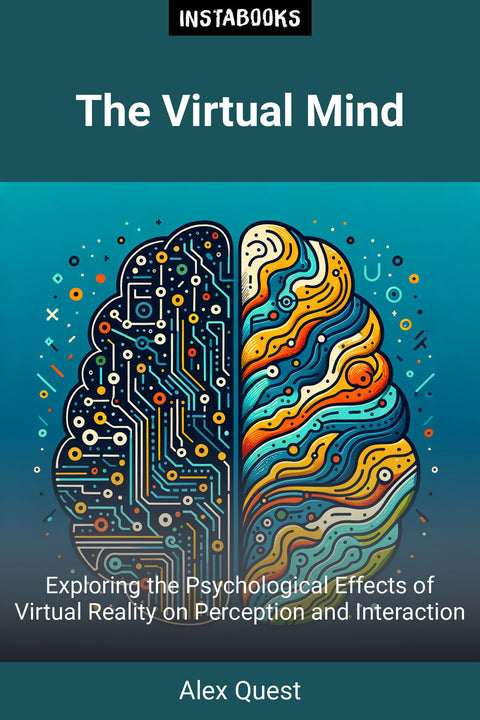
The Virtual Mind
Exploring the Psychological Effects of Virtual Reality on Perception and Interaction
Included:
✓ 200+ Page AI-Generated Book
✓ ePub eBook File — read on Kindle & Apple Books
✓ PDF Print File (Easy Printing)
✓ Word DOCX File (Easy Editing)
✓ Hi-Res Print-Ready Book Cover (No Logo Watermark)
✓ Full Commercial Use Rights — keep 100% of royalties
✓ Publish under your own Author Name
✓ Sell on Amazon KDP, IngramSpark, Lulu, Blurb & Gumroad to millions of readers worldwide
AI Book Preview
Below you'll find a comprehensive preview of all chapters in this book. Each section provides a glimpse into the key concepts, practical insights, and valuable knowledge you'll gain.
Chapter 1: Introduction to Virtual Reality and Psychology
The Evolution of VR Technology
The evolution of VR technology reveals a transformative journey from rudimentary simulations to immersive environments that reshape human perception and interaction. Understanding this progression highlights how technological advancements have enabled VR to become a powerful tool for exploring the mind and behavior.
Psychological Principles Behind VR
Virtual reality leverages core psychological principles, such as presence and embodiment, to profoundly influence how we perceive and interact with digital environments. Readers will explore how VR taps into cognitive and emotional processes, reshaping our understanding of reality and behavior in immersive spaces.
Scope of the Book
The book delves into the transformative potential of virtual reality in reshaping psychological frameworks, offering insights into its applications across therapy, education, and human behavior studies. Readers will explore how VR bridges the gap between the physical and digital worlds, fundamentally altering how we perceive and interact with our environments.
Chapter 2: Therapeutic Applications of VR
VR in PTSD and Anxiety Treatment
Virtual reality is revolutionizing the treatment of PTSD and anxiety by providing immersive, controlled environments for exposure therapy and emotional regulation. Readers will explore how VR’s ability to simulate real-world scenarios safely and effectively enhances therapeutic outcomes and reshapes traditional approaches to mental health care.
Cognitive Rehabilitation Through VR
Virtual reality offers groundbreaking tools for cognitive rehabilitation, enabling patients to engage in immersive, adaptive exercises that enhance memory, attention, and problem-solving skills. This section explores how VR’s ability to simulate real-world scenarios and provide immediate feedback can transform therapeutic outcomes for individuals with cognitive impairments.
Stress Reduction Techniques
Virtual reality offers innovative tools for stress reduction, leveraging immersive environments to promote relaxation and mindfulness. Readers will explore how VR-based techniques, such as guided meditations and calming simulations, can effectively alleviate stress and enhance emotional well-being.
Chapter 3: Negative Psychological Effects
Understanding Dissociation in VR
Dissociation in VR occurs when users experience a disconnection from their physical reality, leading to altered perceptions of self and environment. This section examines the psychological mechanisms behind this phenomenon and its implications for mental health and well-being in virtual spaces.
Risks of VR Addiction
Virtual reality addiction poses significant risks to mental health, including heightened anxiety, social isolation, and an erosion of real-world relationships. This section examines the mechanisms driving VR dependency and its long-term psychological consequences.
Social Isolation and VR
Prolonged use of virtual reality can exacerbate feelings of social isolation, as immersive environments may displace real-world interactions and foster disconnection. This section examines how VR influences social behaviors and the psychological consequences of substituting virtual connections for meaningful, in-person relationships.
Chapter 4: Recent Advancements in VR
Innovative VR Hardware
Recent advancements in VR hardware are revolutionizing how users perceive and interact with virtual environments, offering unprecedented levels of immersion and realism. This section explores cutting-edge innovations, from haptic feedback systems to eye-tracking technology, and their profound implications for psychological engagement and sensory integration.
Customizable VR Environments
Customizable VR environments empower users to design immersive spaces tailored to their psychological or therapeutic needs, offering unprecedented control over sensory stimuli and interaction dynamics. By examining the potential of these environments, readers will uncover how personalization enhances emotional engagement, cognitive flexibility, and behavioral outcomes in virtual settings.
Cutting-edge VR Research
Cutting-edge VR research is revolutionizing our understanding of neural plasticity and sensory integration, revealing how immersive environments can reshape cognitive and emotional processing. Discover how breakthroughs in haptic feedback, brain-computer interfaces, and multisensory simulations are pushing the boundaries of human perception and interaction.
Chapter 5: Comprehensive Insights on VR
VR in Psychiatric Disorders
Virtual reality is revolutionizing the treatment of psychiatric disorders by offering immersive, controlled environments for exposure therapy and cognitive restructuring. This section delves into the latest research and clinical applications, demonstrating how VR can enhance therapeutic outcomes for conditions like PTSD, anxiety, and phobias.
Enhancing Social Skills with VR
Virtual reality offers transformative tools for improving social skills by creating safe, controlled environments to practice interpersonal interactions and build confidence. Readers will explore how VR can address social anxiety, enhance empathy, and foster meaningful connections in both therapeutic and everyday contexts.
Cognitive Reserve and VR
VR has the potential to enhance cognitive reserve by providing immersive, adaptive environments that stimulate neural plasticity and improve mental resilience. This section examines how VR applications can be designed to bolster cognitive functions and delay age-related decline, offering new pathways for mental health and wellness interventions.
Chapter 6: User Experience and VR
Designing User-friendly VR Interfaces
Designing user-friendly VR interfaces requires a deep understanding of human cognition and sensory perception to create immersive yet intuitive experiences. Readers will explore key principles for minimizing discomfort and maximizing engagement in virtual environments.
Psychological Safety in VR
Psychological safety in VR is essential for fostering trust and reducing anxiety in immersive environments, enabling users to fully engage without fear of judgment or harm. This section explores how designers can create emotionally secure virtual spaces and the psychological principles that underpin user comfort and well-being.
User Feedback and Improvements
User feedback is essential for refining VR experiences, as it reveals how users perceive and interact with virtual environments, leading to meaningful improvements. By analyzing user responses, developers and psychologists can identify pain points, enhance immersion, and create more intuitive and psychologically supportive VR systems.
Chapter 7: Ethical Considerations in VR
Privacy Concerns in Virtual Spaces
Virtual reality raises critical privacy concerns as users' data, behaviors, and interactions in virtual spaces are often tracked, stored, and potentially exploited. This section examines the ethical implications of data collection in VR and explores strategies to protect user privacy in immersive environments.
Ethical Use of VR in Therapy
The ethical use of VR in therapy demands careful consideration of patient autonomy, informed consent, and the potential for emotional harm in immersive environments. Practitioners must balance the therapeutic benefits of VR with the responsibility to safeguard users' mental and emotional well-being.
Regulating VR Content
Regulating VR content is essential to prevent psychological harm and ethical violations, as immersive experiences can blur the line between virtual and real-world consequences. This section examines the challenges of establishing effective guidelines, balancing creative freedom with user safety in an evolving digital landscape.
Chapter 8: Future Directions in VR
Predicting VR Trends
The future of VR hinges on advancements in neural interfaces, haptic feedback, and AI-driven personalization, promising unprecedented immersion and psychological impact. Readers will explore how these emerging technologies could reshape human perception, social interaction, and therapeutic applications in the coming decade.
Potential Future Therapies
Virtual reality is poised to revolutionize therapeutic practices by offering immersive treatments for phobias, PTSD, and anxiety disorders through controlled, repeatable environments. Readers will explore how cutting-edge VR therapies could enhance mental health outcomes by leveraging the brain's adaptability and immersive technology’s potential for personalized care.
Integrating VR with Other Technologies
The integration of VR with AI, IoT, and haptic technologies is reshaping immersive experiences, offering unprecedented opportunities for personalized interaction and sensory engagement. This section explores how these synergies are advancing therapeutic applications, enhancing cognitive training, and redefining human-technology interfaces.
Chapter 9: Case Studies
Successful VR Therapy Sessions
Successful VR therapy sessions demonstrate how immersive environments can effectively treat anxiety, PTSD, and phobias by creating controlled, safe spaces for exposure and emotional processing. Real-world examples highlight the transformative potential of VR in enhancing therapeutic outcomes and redefining traditional treatment methods.
Failures and Lessons Learned
Failures in virtual reality applications reveal critical insights into the psychological risks of misaligned perception and unintended behavioral consequences. By examining these case studies, readers will uncover valuable lessons on designing immersive experiences that prioritize user well-being and ethical considerations.
Comparative Studies
Comparative studies reveal how different virtual reality environments influence psychological responses, highlighting key variations in emotional, cognitive, and behavioral outcomes. By analyzing diverse case examples, readers will gain insights into the nuanced ways VR shapes human perception and interaction across contexts.
Chapter 10: Practical Guide to Using VR
Setting Up VR for Therapy
Successfully integrating VR into therapy begins with selecting the right hardware, configuring immersive environments, and ensuring patient comfort and safety. This guide provides step-by-step instructions for therapists to create tailored VR experiences that enhance therapeutic outcomes.
Best Practices for VR Training
Effective VR training requires designing immersive, goal-oriented scenarios that align with real-world applications while minimizing cognitive overload to enhance retention and skill transfer. Readers will explore evidence-based strategies for creating engaging, psychologically safe VR environments that optimize learning and performance.
Maintenance and Troubleshooting
Regular maintenance of VR equipment ensures optimal performance and minimizes disruptions during immersive experiences, while troubleshooting common issues like tracking errors or software glitches enhances user confidence and system reliability. Readers will learn practical strategies to maintain VR systems and resolve technical challenges effectively, ensuring seamless psychological and perceptual exploration.
Chapter 11: Conclusion
Summarizing the Psychological Impacts
Virtual reality profoundly reshapes human perception, cognition, and emotional responses, often blurring the boundaries between the physical and digital worlds. This section synthesizes key findings on how immersive technologies influence mental health, social behaviors, and our sense of self in both beneficial and challenging ways.
The Balanced View of VR
Virtual reality’s dual potential to enhance and disrupt human perception and interaction demands a nuanced, balanced approach to its integration into daily life. By weighing its psychological benefits against potential risks, we can harness VR’s transformative power responsibly and effectively.
Future Research Directions
Future research must address the long-term psychological impacts of immersive virtual environments and explore how emerging technologies can enhance therapeutic applications. Investigating the interplay between virtual reality and neural plasticity will provide deeper insights into optimizing user experiences and mitigating adverse effects.
Chapter 12: The Science of Immersion
How Immersion Affects Perception
Immersion in virtual reality fundamentally alters how individuals perceive and interpret their surroundings, blurring the boundaries between the physical and digital worlds. This section delves into the cognitive mechanisms behind this phenomenon, exploring how heightened sensory engagement reshapes attention, memory, and reality testing.
The Role of Presence in VR
Presence—the feeling of truly "being" in a virtual environment—is the cornerstone of immersive VR experiences, shaping how users perceive and interact with digital worlds. This section delves into the psychological mechanisms behind presence and its critical role in enhancing the effectiveness of VR applications.
Measuring Immersion Levels
Measuring immersion levels involves assessing both physiological responses and subjective experiences to quantify how deeply users engage with virtual environments. Readers will explore cutting-edge methodologies, from EEG and heart rate monitoring to self-reported questionnaires, that reveal the intricate interplay between technology and human perception.
Target Audience
This book is written for psychologists, therapists, technologists, and anyone interested in understanding how virtual reality impacts human perception and interaction.
Key Takeaways
- Understand the therapeutic benefits of VR in mental health treatment.
- Explore the risks of VR, including addiction and dissociation.
- Learn about the latest advancements in VR technology and research.
- Gain insights into the ethical considerations of using VR in therapy.
- Discover practical applications of VR in enhancing social skills and cognitive rehabilitation.
